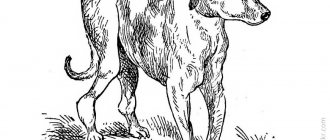Bronchitis is often the cause of coughing in dogs. This is an inflammatory disease of the bronchial mucosa (“windpipe”). Without timely diagnosis and treatment, bronchitis is a dangerous disease that can even lead to death. Read on to learn how to prevent this, what symptoms to look out for, and whether bronchitis is contagious in dogs.
Read in this article:
Common causes of bronchitis in dogs What can the disease be? Symptoms of bronchitis in a dog Forms of bronchitis: acute and chronic Diagnosis of the disease How is bronchitis treated in a dog? Physiotherapy Proper animal care
Common Causes of Bronchitis in Dogs
One of the common factors that provoke the development of bronchitis in dogs of different ages and breeds is hypothermia. It occurs when your pet walks for long periods of time outdoors at low temperatures, in the rain or in strong cold winds.
Bronchitis often occurs in animals that bathe in cold water reservoirs, and also live in poorly heated and damp rooms. If we are talking about long-haired breeds, then hypothermia can be caused even by undried wool after water treatments.
Other reasons that can lead to the development of bronchitis in a dog include:
- Poor living and maintenance conditions. Damp and poorly heated rooms, location on a cold floor, drafts - all this can lead to weakening of the animal’s body and inflammation of the respiratory tract;
- Poor nutrition. The absence or deficiency of vitamins and minerals in a pet’s diet leads to weakened immunity and a deterioration in the protective functions of the respiratory tract epithelium;
- Allergens. Another common cause of bronchitis in dogs is allergic reactions. The most common allergens include cigarette smoke, pollen, house and construction dust, aggressive household chemicals, etc.;
- Parasitic diseases. Inflammation occurs when parasite larvae begin to migrate (move) from the internal organs to the respiratory tract. Moreover, they can even enter large or small bronchi, increasing the severity of bronchitis;
- Infections. Causative agents of various infections (for example, parvovirus enteritis or viral tracheitis) can provoke the occurrence of bronchitis in an animal. Pathogens penetrate the bronchi of the pet through the blood or lymph flow;
- Pathologies of the respiratory system. They weaken the airways, affect the mucous membranes and can cause bronchitis. Such diseases include pneumonia, tracheitis, laryngitis, etc.
Various factors can trigger bronchitis in dogs. In some cases, it is enough to exclude them for the animal’s condition to improve; in others, additional treatment is required.
Preventive measures
It is necessary to urgently show the dog to the veterinarian.
To prevent shortness of breath, it is recommended to provide the dog with good care. Food should include all vitamins and minerals, especially iron and calcium. You need to check your heart function often and protect your pet from infectious diseases.
If the breed is prone to shortness of breath, you should regularly visit the veterinarian and monitor the condition of the respiratory tract. If a dog has serious illnesses or injuries to the central nervous system (for example, epilepsy or concussion), you must carefully monitor its well-being and follow all the veterinarian’s prescriptions.
When walking, do not tighten the collar or harness on the dog's neck too tightly. A tight and tight collar will constantly suffocate your pet. This will inevitably lead to breathing problems.
Important! The dog needs a soft and elastic collar that does not put pressure on the neck.
You need to take care of the puppy’s health from the first days of its life, then the adult dog will always feel good. You need to feed your furry pet well and choose a comfortable collar for it.
What could the disease be?
There are different types of bronchitis in dogs. They differ not only in signs, but also in treatment features, so they must be determined by the veterinarian who examines and diagnoses the animal. These types of bronchitis include:
- Hemorrhagic . It is accompanied by hemorrhages in the bronchial mucosa, so the animal suffers from hemoptysis even outside of coughing attacks. This is the most dangerous form of the disease;
- Fibrinous . The main feature is that cough sputum contains the protein fibrin, which has a gray-yellow tint;
- Catarrhal . An additional sign indicating catarrhal bronchitis is profuse mucous discharge when coughing;
- Putrid . Already from the name it becomes clear that this form of bronchitis is accompanied by a sharp putrefactive odor that occurs against the background of a developing infection;
- Purulent . A characteristic feature of this form of bronchitis is sputum, which contains purulent inclusions.
Prevention
Some causes of wheezing cannot be prevented. However, infectious causes such as kennel cough, heartworm disease, hookworms, roundworms and highly infectious viruses such as distemper can be prevented with proper vaccination and internal parasite control.
A heartworm infection can be fatal—signs such as wheezing may not be present until the infection is too advanced to be treated.
When your veterinarian reminds you about heartworm prevention for your dog, make sure you get it and give it to your dog regularly as your veterinarian advises, and follow all vaccine recommendations for your dog.
Symptoms of bronchitis in a dog
A characteristic sign of bronchitis is a cough. It may be dry or wet (with sputum production). As for the duration of coughing, attacks can last from several seconds to several minutes. The cough can be short, with the animal quickly recovering, or long-lasting, even to the point of vomiting.
On a note! Coughing attacks become noticeably worse even with minor physical activity (for example, running), pulling on a leash, or staying in cold air.
Other symptoms of bronchitis in dogs:
- discharge of mucous exudate from the nose,
- increase in heart rate,
- difficulty (heavy) breathing,
- vomit,
- shortness of breath and wheezing,
- loss of appetite,
- apathetic and lethargic state,
- fast fatiguability,
- increase in body temperature,
- dull and rough coat.
Signs of the disease depend on its form.
What to do
Treatment depends on the cause of the wheezing. In the case of foreign bodies, your veterinarian will likely sedate your dog and remove the foreign body using medical instruments. If your dog is wheezing due to infectious causes, treatment will be aimed at eliminating them.
If wheezing is caused by allergic asthma or bronchitis, your veterinarian will tell you about medications that can be used to control the condition and what you can do at home to reduce allergens for your dog, such as vacuuming, HEPA air filters, and so on.
If the wheezing is caused by heart disease, your veterinarian may prescribe medications to help the heart pump blood stronger and more easily. Wheezing due to a collapsed trachea can be treated with cough medicine and monitoring the pet's environment, meaning making sure the pet has a cool place to rest where it can't overheat.
Forms of bronchitis: acute and chronic
Along the way, there are two more forms of bronchitis in dogs - acute and chronic . Each of them has its own characteristics, which are important to consider when diagnosing and treating the disease:
- Spicy . Most often, the acute form of bronchitis occurs against the background of a viral infection. Inflammation develops quickly, appetite worsens. Characteristic signs include difficulty breathing and oxygen deprivation (hypoxia). There may be a slight increase in body temperature.
- Chronic . It differs in that the disease develops gradually and is replaced by periods of remission. The dog has periodic coughing attacks. Breathing is difficult, wheezing is possible. As with the acute form, the animal has no appetite, so the dog rapidly loses weight.
Signs characteristic of shortness of breath
To understand why your dog is breathing hoarsely, you need to remember the main signs of shortness of breath. At the first symptoms, you need to help your pet and go to the veterinarian.
Types of shortness of breath:
- A short inhalation and a long, heavy exhalation (expiration) - this happens with asthma and bronchitis.
- A sharp, heavy, short breath (inspiration) - pulmonary edema, injury to the chest and respiratory organs, foreign body.
- Both inhalation and exhalation are difficult (mixed type) - pneumonia, heart failure, inflammatory process.
All types of shortness of breath have extensive symptoms:
- the dog cannot breathe with its mouth closed;
- the dog wheezes as if suffocating;
- cough;
- pale or bluish tint of mucous membranes;
- the dog makes a great effort to breathe;
- whistling, wheezing;
- the dog stretches its body and spreads its front paws wide;
- At first there is severe anxiety, and then the dog becomes indifferent to what is happening.
The animal must be helped immediately, otherwise irreversible pathology and death may develop.
When choking, the dog may open its mouth and stick out its tongue.
Diagnosis of the disease
It is impossible to make an accurate diagnosis at home, so entrust this task to a specialist at a veterinary clinic. The doctor will examine the dog, ask the owner a few questions and order additional tests.
Basic methods for diagnosing bronchitis:
- listening to the lungs (auscultation),
- tapping the lungs (percussion),
- bronchoscopy,
- radiography,
- blood tests,
- throat swab,
- bacteriological culture.
Based on the research results, the veterinarian makes an accurate diagnosis and prescribes effective treatment that meets all the characteristics of the dog’s body and condition.
How is bronchitis treated in a dog?
Treatment of bronchitis is often carried out at home, so there is no need to place the dog in a hospital. Therapy is aimed at eliminating the symptoms and causes of the disease. For this purpose, veterinarians prescribe various medications:
- Expectorants and antispasmodics . They eliminate spasms, and also dilute and accelerate the removal of mucus from the respiratory tract, alleviating the animal’s condition;
- Anthelmintics . They are prescribed if bronchitis is caused by parasitic diseases. Such drugs are effectively used for the treatment and prevention of helminthiasis;
- Bronchodilators . They relax the muscles of the bronchi, thereby expanding the airways. Drugs in this group are common in the form of aerosols, so they are convenient to use;
- Antihistamines and glucocorticosteroids . Help with allergic reactions and also prevent their occurrence;
- Other medicines . These include cardiac glycosides (improve and restore the functions of the cardiovascular system), mucolytics (thin sputum), and antibiotics (fight bacterial infections).
All medications for the treatment of bronchitis in dogs must be taken strictly as prescribed by a veterinarian!
Physiotherapy
In complex therapy of bronchitis, dogs are often prescribed physiotherapeutic procedures. These include heating with an infrared lamp, ultra-high-frequency therapy (exposure to the animal’s body with a high-frequency electromagnetic field), as well as diathermy (electrotherapy). Each of these procedures facilitates the removal of sputum, restores the pet’s body and strengthens its immune system.
On a note! Additionally, the dog may be prescribed inhalations. They stop coughing and prevent new attacks.
First aid for a pet if he is choking
If the owner notices that the dog is grunting with its nose, as if it is choking, it is necessary to provide first aid to the pet, and then go to the veterinary clinic.
How to help your dog:
- Place the dog in a well-ventilated room where there are no drafts.
- Provide your pet with complete rest and do not disturb him.
- Urgently call a veterinarian at home or go to the clinic yourself.
- Give the dog suprastin for swelling. For an animal weighing 5–8 kg you will need half a tablet. The tablet must be crushed and rubbed under the tongue.
- If a dog refuses to eat or drink, you cannot force it.
- Give Gamavit injections - one injection into the large muscles on each paw. The medicine must be administered in equal doses.
- Gently massage your pet's chest, abdomen, ears and back.
- You can give an injection of potassium chloride. Depending on the size and weight of the animal, from 3 ml to 15 ml of medication is drawn into the syringe and injected very carefully and slowly.
- If necessary, you can do a closed heart massage if the owner knows how to do it.
At the veterinary clinic, the doctor may put an oxygen mask on your pet or perform artificial ventilation. Most likely, a sick dog will need surgery.
The mucous membranes of the mouth turn pale or blue
Proper animal care
The first step is to provide warmth and rest to a dog suffering from bronchitis. To do this, provide your pet with a comfortable and dry place to sleep in a heated room. The veterinarian gives recommendations on nutrition individually, but in any case you will need easily digestible food with multivitamins. If natural food is used, it should be soft and warm. Walking in bad weather should be kept to a minimum. All treatment prescribed by a specialist must be strictly followed. It is impossible to interrupt therapy, even if the symptoms of bronchitis disappear.
By following these simple recommendations, you will ensure a quick recovery for your dog!
When to contact a veterinarian
If your pet is choking, you should contact your veterinarian as soon as possible for any symptoms.
It is necessary to urgently treat your dog if it develops life-threatening symptoms:
- the dog is trembling (runny nose, wheezing, heavy breathing);
- mucous membranes have turned blue or pale;
- the tongue falls out of the mouth;
- convulsions;
- heart attack.
You need to calm your pet down and call a doctor immediately. If the dog is not helped in time, it may suffocate.
Important! Dyspnea (difficulty breathing) should not be confused with tachypnea (fast but not heavy breathing). Tachypnea often develops after running and physical activity.
The pet should be placed in a cool place and given medicine











